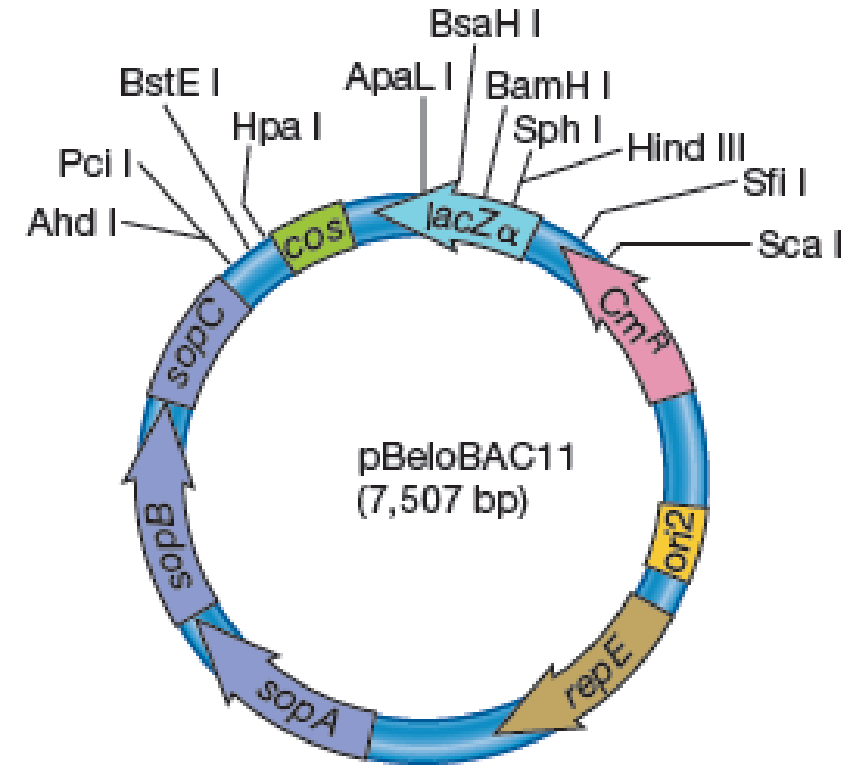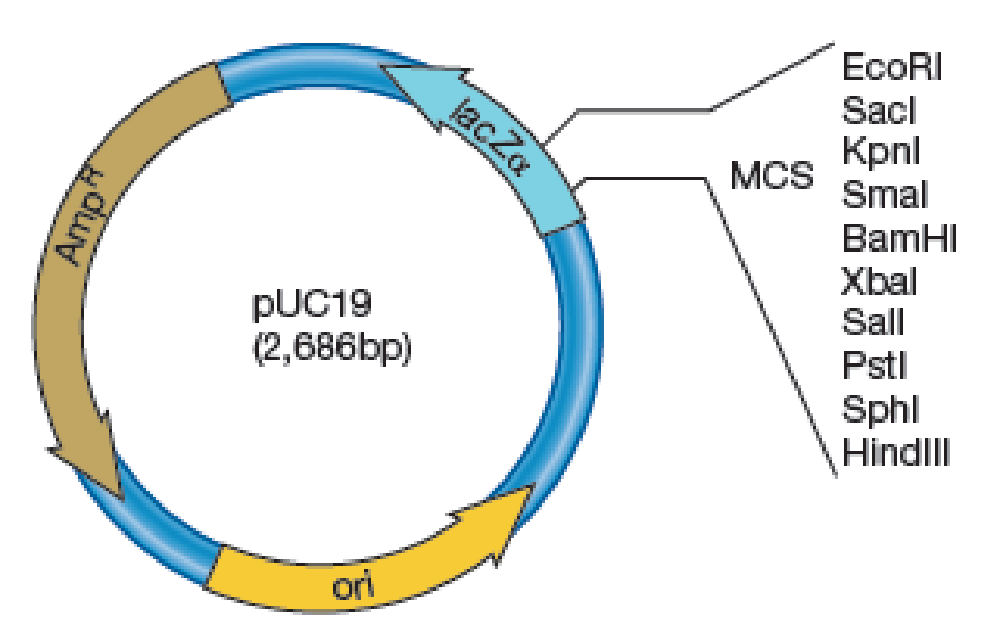
Prescott's Microbiology
11th Edition
ISBN: 9781260211887
Author: WILLEY, Sandman, Wood
Publisher: McGraw Hill
expand_more
expand_more
format_list_bulleted
Concept explainers
Textbook Question
Chapter 17.1, Problem 7MI
In what ways does the BAC shown here differ from the plasmid pUC19 shown in figure 17.10?
Bacterial artificial chromosome (BAC)

Figure 17.10

Expert Solution & Answer
Want to see the full answer?
Check out a sample textbook solution
Students have asked these similar questions
In Figure 5-19, how many different bacterial species areshown as having contributed DNA to the plasmid pk214?
pXO1 and pXO2 are large plasmids – large pieces of DNA that are not the chromosome that can replicate independently of the chromosome. What can a Bacillus anthracis cell with a pXO2 plasmid do that a cell without pXO2 can’t?
I need help answering this quwhstion as short as possible based of what is said in the paper
On Figure 1, what is occurring at the positions C indicated by black arrows?
Chapter 17 Solutions
Prescott's Microbiology
Ch. 17.1 - Examine the uncut piece of DNA shown in the upper...Ch. 17.1 - Which of the above enzymes yield blunt ends? Which...Ch. 17.1 - Prob. 3MICh. 17.1 - What would you conclude if you obtained only blue...Ch. 17.1 - Why must introns be removed from eukaryotic DNA...Ch. 17.1 - Which plasmid is a shuttle vector? Why?Ch. 17.1 - In what ways does the BAC shown here differ from...Ch. 17.1 - Describe restriction enzymes, sticky ends, and...Ch. 17.1 - What is cDNA? Why is it necessary to generate cDNA...Ch. 17.1 - Prob. 3CC
Ch. 17.1 - Prob. 4CCCh. 17.1 - Prob. 5CCCh. 17.2 - Why, after three cycles, are the vast majority of...Ch. 17.2 - Briefly describe the polymerase chain reaction....Ch. 17.2 - Why is PCR used to detect infectious agents that...Ch. 17.2 - How would you use PCR to measure the concentration...Ch. 17.2 - Why is it possible to visualize a PCR product on...Ch. 17.2 - Prob. 5CCCh. 17.3 - Why are long fragments (e.g., 20,000 bp) of...Ch. 17.4 - What special considerations are necessary if one...Ch. 17.4 - Prob. 1CCCh. 17.4 - Prob. 2CCCh. 17.4 - Prob. 3CCCh. 17.4 - You are studying chemotaxis proteins in a newly...Ch. 17.5 - Prob. 1MICh. 17.5 - Prob. 1CCCh. 17.5 - Prob. 2CCCh. 17 - Which of the DNA molecules shown are recombinant?Ch. 17 - Prob. 1RCCh. 17 - Prob. 2RCCh. 17 - Prob. 3RCCh. 17 - Prob. 4RCCh. 17 - Prob. 5RCCh. 17 - Prob. 6RCCh. 17 - Prob. 1ALCh. 17 - Prob. 2ALCh. 17 - Suppose you transformed a plasmid vector carrying...Ch. 17 - You are interested in the activity and regulation...Ch. 17 - Prob. 5ALCh. 17 - Prob. 6ALCh. 17 - Prob. 7AL
Knowledge Booster
Learn more about
Need a deep-dive on the concept behind this application? Look no further. Learn more about this topic, biology and related others by exploring similar questions and additional content below.Similar questions
- In Figure 5-2, in which of the four processes shown can acomplete bacterial genome be transferred from one cellto another?arrow_forwardThe transfection reagent used to introduce plasmids to the HEK293 cells was a lipid reagent. Why is lipid utilized for this procedure?arrow_forward1 (a) What do ApR, TcR, and ori on the pBR322 map represent and discuss there individual functions? (b)Does the undigested plasmid show more than a single band when electrophoresed? Why? (c)What other kinds of molecules, in addition to plasmid DNA would you expect to find in a sample of plasmid DNA extraction? (This is not a graded assignment)arrow_forward
- 1) Given the image below, describe what is happening at each of the 3 sections (i.e. 1, 2, and 3) . [In section 1, the gene donor is providing..., In section 2..., In section 3...]arrow_forwardYou have two cell cultures, each containing a different plasmid. The first plasmid is ~5kbp long and contains three 5'-TCGA-3' and the other is the same size, but only contains two 5'-TCGA-3' sequences. You forget to label the two cell cultures you grew and have to figure out which one contains each plasmid. How would you go about identifying the the two cultures.arrow_forwardThe gene atg-12 codes for a protein associated with abnormal rates of cell destruction and recycling of cell contents. Scientists studying bacterial plasmids devised an experiment using recombinant DNA techniques to remove a section of DNA (gene atg-12) of a bacterial plasmid (pOKE103) and create a new plasmid (pOKE104) that did not contain the gene atg-12. The new plasmid was then incorporated within the DNA of the fungus Neurospora crassa in cellular studies. Which statement explains the expected heredity of fungi that incorporate pOKE104? A - Fungi that incorporate pOKE104 will produce the protein from gene atg-12 and have increased rates of malignant tumors. B - Fungi that incorporate pOKE104 will not produce the protein from gene atg-12 but will have a normal appearance. C - The prokaryotic DNA will remain separate within the fungal cells, produce the protein from gene atg-12, and have increased rates of malignant tumors. D - The prokaryotic DNA will remain separate within the…arrow_forward
- In Figure 10-14, why does DNA migrate to the anode(+ pole)?arrow_forwardYou are about to isolate a 3000 bp large plasmid from an E.coli culture. You know that the plasmid is present in 100 copies per E. coli cell. You aim to have a final plasmid concentration of 100 ng/µl in a total volume of 50 µl. Assuming the yield is 100 %, how many E. coli cells should the culture from which the plasmid is to be isolated at least containarrow_forwardA cloning vector map is shown below. EcoRI Bam Ban Hind P-galactosidase Amp Bam Bam EcoRI Ori C Which restriction site is best for inserting a DNA fragment for selection of chimeric plasmid containing colonies? 1) They're all equally good. 2) Hindll 3) EcoRI 4) BamHIarrow_forward
- You are interested in synthesizing a variant of Synechocystis sp. pcc 7803 ferredoxin having mutation (E) at its 38th residue. The gene is encoded in a pET21b vector (5.3 kbp). If you use 0.10 ng of the template plasmid (pET21b SynFd), calculate the ratio of the original to the mutated gene after 10 versus 20 cycles.arrow_forwardWhat color colonies will cells that contain a recombinant plasmid form?arrow_forwardIf the recipient cell did not already have a lys− gene, could the lys+ DNA become incorporated into the bacterial chromosome? Explain.arrow_forward
arrow_back_ios
SEE MORE QUESTIONS
arrow_forward_ios
Recommended textbooks for you
 Concepts of BiologyBiologyISBN:9781938168116Author:Samantha Fowler, Rebecca Roush, James WisePublisher:OpenStax College
Concepts of BiologyBiologyISBN:9781938168116Author:Samantha Fowler, Rebecca Roush, James WisePublisher:OpenStax College


Concepts of Biology
Biology
ISBN:9781938168116
Author:Samantha Fowler, Rebecca Roush, James Wise
Publisher:OpenStax College
Bacterial Genomics and Metagenomics; Author: Quadram Institute;https://www.youtube.com/watch?v=_6IdVTAFXoU;License: Standard youtube license